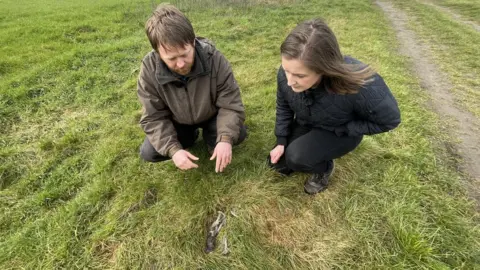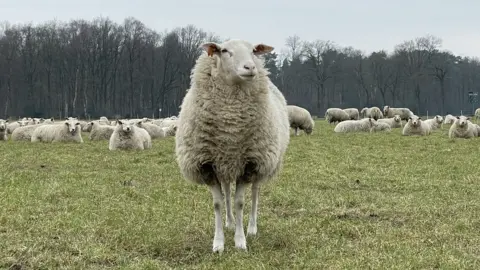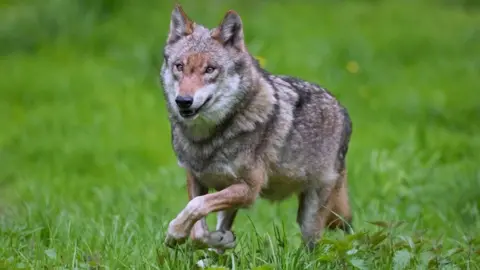Wolves back in Belgium after 100 years, sparking controversy
Jan Gouwy is showing us how to track wolves.
The researcher from the Flemish Institute for Nature and Forest Research (INBO) walks us along a countryside track in Belgium's eastern province of Limburg.
It's not long before he spots a wolf print that most of us would never notice. The front paw track, lightly pressed into the mud, is probably just a few days old.
For the first time in more than 100 years a small number of these predators has started to settle here.
Wolves were once widely hunted in Europe. Local folklore says that, before their recent return, the last wolf in Belgium was shot by the nation's King Leopold II in the 1890s.
Estimates vary but around 15 to 20 wolves are currently thought to be in the country, with one pack in Flanders plus another in southern Wallonia, as well as a newly settled pair.
Numbers are much higher in, for example, neighbouring France and Germany, where hundreds of the predators are now thought to live. The UK government meanwhile has ruled out re-introducing wolves.
It's part of a wider expansion in Europe that's triggering alarm in some communities, while being welcomed by conservationists.
But this animal's resurgence, while not down to just one factor, is certainly no simple act of nature.
"The reason why they are back is mainly legal protection," says Jan.
Protection for wolves came in under the Bern Convention and subsequent 1992 EU Habitats Directive. This prohibited the deliberate capture or killing of a wolf, with some exceptions.
"From the early 1990s, a lot has happened in Europe, and the wolf really started to disperse all over the continent," Jan explains.

A Europe-wide assessment in September 2022 said that, "after a severe reduction in the first half of the 20th Century", the best available data now suggested that "the total number of wolves in the 27 EU member states is likely to be in the order of 19,000".
Jan spies the remains of wolf faeces which, after rainfall, now chiefly consists of the hairs of its prey.
Dietary analysis in the area has found that the wolves mainly eat roe deer and wild boar.
But around 15% of their diet is livestock. That's something local sheep farmer Johan Schouteden knows well.
"The wolf is always on our mind," he tells me as we stand under a light drizzle of rain in a field where his sheep are grazing, hemmed in by an electric fence.
"We can use more wires, use more sticks. A wolf-proof fence doesn't exist. The wolf is so smart, he overruns every fence."

Dozens of his sheep, he says, have been killed since wolves first started reappearing in this part of Belgium in 2018.
The situation has sparked protests in recent years, with 3,000 locals joining a demonstration in 2021.
Johan has photos of his dead livestock, but many of them are too graphic to publish.
There is compensation for lost animals and money for electric fencing but Johan says this doesn't cover the true cost.
"I want to live with the wolf," he says. "If we get paid for all the extra labour and all the extra work we have to do."
Others are advocating for more radical counter-measures, with some EU lawmakers recently voting for a downgrade in the wolf's protected status.
It was a non-binding resolution but those in favour argue that the population can't be allowed to grow without stronger controls.
In Sweden, 57 wolves were shot between January and February in a government-licensed cull. Opponents have questioned the legality of the cull.
The issue also gained fresh attention when Dolly, a pony belonging to European Commission President Ursula von der Leyen, was killed by a wolf in Germany last year.
The wolf - whose official name is GW950m - has now been licensed for shooting as it's been linked to repeated attacks. A Commission assessment of the wider situation isn't expected to see the 1992 Habitats Directive reopened, but rather existing flexibilities explored.
Back out on the trail in Belgium with Jan Gouwy he says that, after over a century without any wolves, it's unsurprising their return has sparked some "panic".
"People need to adapt their behaviour. They need to build solid fences. If they do so, it's perfectly possible to co-exist with wolves."
 Getty Images
Getty ImagesBut, I ask Jan, what's actually positive about the resurgence of wolves in Europe?
He says that the predators help repress disease levels because they prey on the sick and the young - and hits back with his own question.
"You need to ask if everything has to have a positive effect on the way we see it as humans," he says.
"Maybe some animals just have a right to exist, not just because we find them useful."
We don't see any wolves during our walk in Limburg, though you can spot the signs with the help of an expert eye.
Those paw prints mark the quiet return of this predator, and the start of a rekindled human clash with nature.
